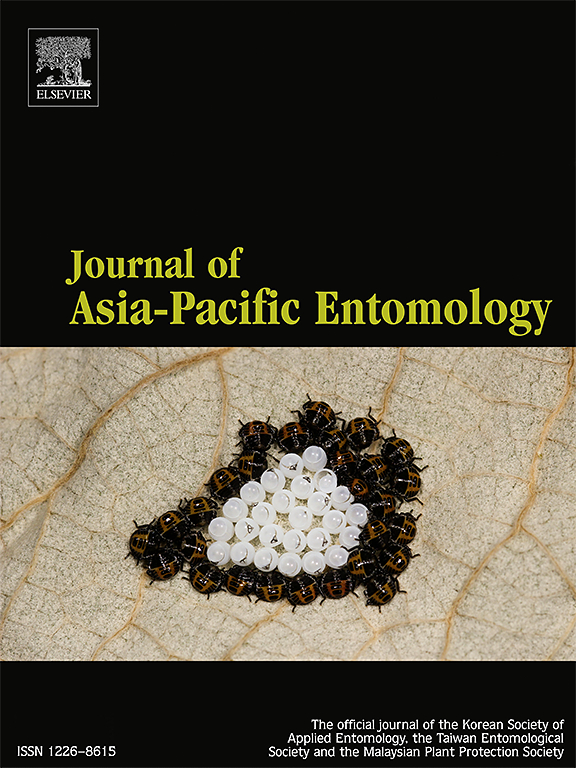Resistance allele frequencies of Chilo suppressalis populations to Cry1Ab in Chongqing
IF 1.3
3区 农林科学
Q3 ENTOMOLOGY
引用次数: 0
Abstract
Transgenic rice expressing Bacillus thuringiensis (Bt) insecticidal toxins for insect resistance represent a novel method of controlling Chilo suppressalis; however, potential resistance of pests to Bt toxins is a key factor restricting sustainable application of transgenic Bt crops. Here, we assessed the initial risk of resistance to transgenic Bt rice in local C. suppressalis populations in the municipality of Chongqing in China by testing their sensitivities to Bt proteins and determining resistance allele frequencies. Toxicity testing showed that sensitivity of C. suppressalis populations to Bt toxins (Cry1Ab and Cry1Ac) varied across geographical areas (LC50 ranges, 1.39–7.14 and 3.02–8.81 mg/L, respectively), with sensitivity of the Fengjie population to Cry1Ab 5.13-fold that of the Nanchuan population. F2 screening showed that resistance allele frequencies to Cry1Ab in C. suppressalis larvae, pupae, and adults in Chongqing were 0.0048, 0.0050, and 0.0053 during 1999–2021, respectively. After 20 generations of resistance selection using Cry1Ab, the resistance level of the C. suppressalis population was 15.67-fold that of the initial population. These results demonstrate the presence of Bt protein-resistant C. suppressalis individuals, and a risk of producing resistant C. suppressalis populations, in the field in Chongqing, China.

重庆地区抑制螟种群对Cry1Ab抗性等位基因频率分析
表达苏云金芽孢杆菌(Bacillus thuringiensis, Bt)杀虫毒素的转基因水稻具有抗虫性,是一种防治黄萎病的新方法。然而,害虫对Bt毒素的潜在抗性是制约转基因Bt作物可持续应用的关键因素。在这里,我们通过测试中国重庆当地抑制螟种群对Bt蛋白的敏感性和测定抗性等位基因频率,评估了对转基因Bt水稻的初始抗性风险。毒力试验结果表明,不同地域的抑孢棉铃虫种群对Cry1Ab和Cry1Ac的敏感性差异较大(LC50分别为1.39 ~ 7.14 mg/L和3.02 ~ 8.81 mg/L),其中丰节种群对Cry1Ab的敏感性是南川种群的5.13倍。F2筛选结果显示,1999-2021年重庆地区抑制蠓幼虫、蛹和成虫对Cry1Ab的抗性等位基因频率分别为0.0048、0.0050和0.0053。利用Cry1Ab进行抗性筛选20代后,抑孢粉蚧群体的抗性水平为初始群体的15.67倍。这些结果表明,在中国重庆的田间存在抗Bt蛋白的抑孢梭菌个体,并且存在产生耐药抑孢梭菌群体的风险。
本文章由计算机程序翻译,如有差异,请以英文原文为准。
求助全文
约1分钟内获得全文
求助全文
来源期刊

Journal of Asia-pacific Entomology
Agricultural and Biological Sciences-Insect Science
CiteScore
2.70
自引率
6.70%
发文量
152
审稿时长
69 days
期刊介绍:
The journal publishes original research papers, review articles and short communications in the basic and applied area concerning insects, mites or other arthropods and nematodes of economic importance in agriculture, forestry, industry, human and animal health, and natural resource and environment management, and is the official journal of the Korean Society of Applied Entomology and the Taiwan Entomological Society.
 求助内容:
求助内容: 应助结果提醒方式:
应助结果提醒方式:


